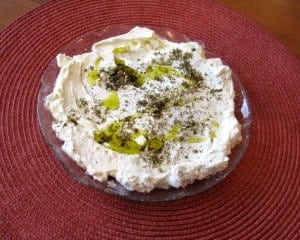 Proust had his madeleines. For me, opening a container of za’atar releases an aroma that sparks memories of strolling through the shuk, the golden light caresssing ancient stone walls. The scent also stimulates my appetite for fresh-from-the-oven pita, warm, soft and chewy, with a salty and piquant tang.
Proust had his madeleines. For me, opening a container of za’atar releases an aroma that sparks memories of strolling through the shuk, the golden light caresssing ancient stone walls. The scent also stimulates my appetite for fresh-from-the-oven pita, warm, soft and chewy, with a salty and piquant tang.
The za’atar that we know from its association with labneh and hummus on mezze plates is a condiment made from a mix of spices, herbs, and seeds, and the recipe varies from place to place.
But in fact, the name za’atar also applies to a family of related herbs that grow in the Middle East: oregano, savory, marjoram, thyme. I think it most closely resembles oregano, at least the bush that grows in my garden.
It’s really easy to mix your own za’atar if you can’t get it locally, or if you simply love the idea of making something from scratch. Just mix the following ingredients together:
- 1/4 cup sumac
- 2 tablespoons thyme
- 1 tablespoon roasted sesame seeds
- 2 tablespoons marjoram
- 2 tablespoons oregano
- 1 teaspoon coarse salt
 This past Saturday evening, we hosted the first of two groups of people that won a Middle Eastern feast at a charity auction. To prepare for this event, I scoured my collection of recipes gathered and adapted over the years. Wild rice stuffed grape leaves. Labneh with za’atar and olive oil. Soft, fluffy pita bread.
This past Saturday evening, we hosted the first of two groups of people that won a Middle Eastern feast at a charity auction. To prepare for this event, I scoured my collection of recipes gathered and adapted over the years. Wild rice stuffed grape leaves. Labneh with za’atar and olive oil. Soft, fluffy pita bread.